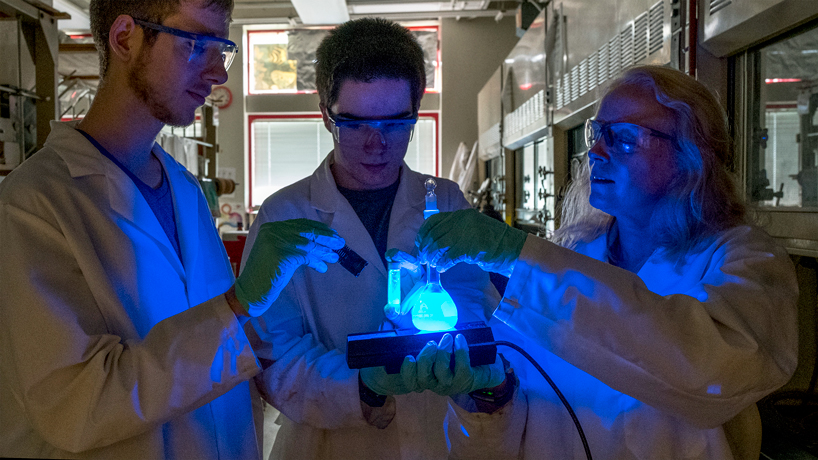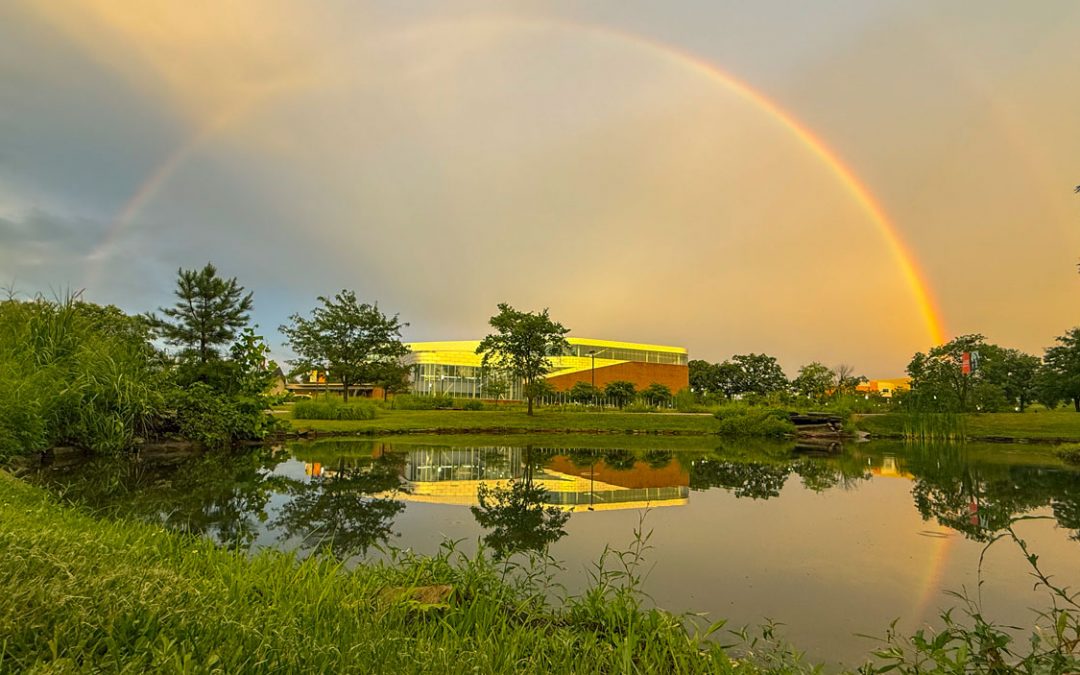
Graduate student Steven Skaggs (at left), STARS student Preston Willis (center) and Associate Professor Janet Wilking demonstrate the fluorescent property of the silicon and germanium compounds they synthesize in Wilking’s chemistry lab at UMSL. The compounds can be used in OLEDs, known for lighting screens of electronic devices. Blue OLEDs are particularly interesting for their tendency to not last as long, a problem Wilking and her research students are solving by creating stronger, more stable blue-emitting molecules. (Photos by August Jennewein)
The bright blue substance glowing from the vials in Janet Wilking’s laboratory could one day help light the screen of your electronic device.
The associate professor of chemistry at the University of Missouri–St. Louis builds luminescent silicon and germanium compounds that can potentially be used in organic light-emitting diodes or OLEDs, best known for lighting the screens of smartphones, tablets and televisions. The synthesized compounds may also be potentially used in chemical and biological sensors.
Specifically, Wilking focuses on building compounds that emit blue light. Why are blue emitters so special?
“There’s actually a need for them,” Wilking said. “Some of the organic molecules that are blue emitters are not stable enough to be useful. A lot of the molecules that we’ve been making are blue emitters and appear to be very stable at elevated temperatures.”

Both Janet Wilking (center) and Steven Skaggs (at right), along with a doctoral student and two undergraduate researchers in the lab, have served as mentors to Preston Willis (at left), who is gaining research experience through the STARS program the summer before his senior year of high school at Westminster Christian Academy.
Compared to other colors on the spectrum, blue requires higher energy emission that can result in blue OLEDs not lasting as long and being a lot pricier. Strong, stable blue emitters are a step toward solving this problem.
That’s something that attracted Preston Willis to Wilking’s lab.
A student in the precollegiate Students and Teachers as Research Scientists program at UMSL, Willis is gaining university research experience over the summer before the start of his senior year of high school at Westminster Christian Academy this fall.
He called Wilking’s research “a revolutionary breakthrough method” in creating stable blue emitters.
Wilking and her team, including one doctoral candidate, one master’s student and two undergraduate students in addition to Willis, build these compounds from their basic framework up. Afterward, they store the compounds in tiny vials.
“Here is one of the white compounds that we have created,” said Willis as he showcased the vial with the synthesized compound.
When an ultraviolet light is cast on it, it luminesces its color, blue.
While most are bright blue, experimenting with different chemical additions has resulted in a few bluish-green specimens.
The National Science Foundation has funded Wilking’s research, granting her $240,000 for a two- to three-year period. She also has UM System FastTrack funding to help with commercialization and collaborates with researchers who plan to use the Wilking lab compounds to build OLEDs at Iowa State University.
Getting in on the early stage of such innovative research with the potential to advance technology is a big deal for a high school student.
“It’s a tremendous experience for them [STARS program students],” Wilking said. “They get to work on projects that are cutting-edge – things that most students probably don’t attempt until they’re in their second or third year of undergraduates studies. Of course, they work closely with their mentors.”
In the coming days, Willis will reach the point where he adds on the final chemical structures that make the molecule he helped build luminesce.
“It’s been a great learning experience,” he said. “In high school labs, you’ll do a couple of reactions a lot of times; they’re very basic reactions. So when I got into this lab, I might have known 10 percent of the specialized chemistry that they are doing. Over time, my fellow researchers helped teach me about all of the intricate concepts. I’ve learned a lot and am grateful for this opportunity.”
“They pick it up really quickly,” Wilking said. “It’s amazing. Usually if you show them or talk to them about a particular technique, they just pick it up right away. They’re so bright.”
After high school, Willis has his sights set on a double major in either chemistry or physics and business. Like many STARS students, he feels his collegiate research experience will serve him well and prepare him for the rigors of college.
Each summer, the STARS program pairs academically talented high school students with local scientists and top researchers from Array Bridge, Confluence Discovery Technologies, the Donald Danforth Plant Science Center, Saint Louis University, Washington University in St. Louis and its host institution, UMSL. STARS graduates are among the most sought-after college-bound high school students in the country.
Janet Wilking graduated from the University of Missouri–St. Louis with a bachelor’s degree in chemistry in 1985. She earned her master’s and doctoral degrees in chemistry from Washington University in St. Louis and went on to complete a chemistry postdoctorate at Harvard University before returning to St. Louis to work in Mallinckrodt Pharmaceuticals for two years. Wilking accepted a faculty position at UMSL in 1993. She was UMSL’s 2014 Inventor of the Year for her work on the luminescent silicon and germanium compounds.















